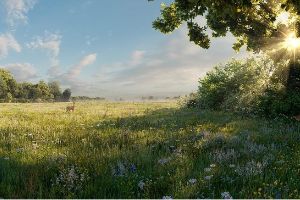Over 10,000 Plants Sown As Major Buckinghamshire Nature Restoration Project Gets Underway

(Image of a Habitat Bank. Credit: Environment Bank)
Planting has this week begun at Milton Keynes first Habitat Bank, thanks to local landowner Joseph Soul and Biodiversity Net Gain specialists, Environment Bank. This includes 1.37 kilometres of hedgerow, incorporating 6,850 whips (young trees) and 5.7 acres of mixed native scrub with over 4,660 plants including field maple, hazel, crab apple, wild service and hawthorn. This is the first stage of planting, alongside the preparation of soil, ready for species-rich grassland and meadow planting in 2024. In total, the biodiversity project will cover 94 acres of restored land, once complete.
Mr Soul owns Wood Farm, a working farm and a family-run campsite, which is situated to the south of Emberton. He was eager to have a Habitat Bank to further diversify the land, create a new income stream for him and provide a range of benefits to nature.
The new Habitat Bank has seen the conversion of Mr Soul’s arable fields into fields of predominantly neutral grassland with an area targetting lowland meadow. A series of hedgerows are to be planted in addition to a belt of mixed native scrub adjoining the mature hedgerow. The new habitats have the potential to attract species not currently present in the area including birds such as the nightingale, garden warbler, and turtle dove.
Commenting on the project, Mr Soul said: “Habitat Banks are going to be vital to supporting nature's recovery and we are thrilled to be one of the first landowners to get a scheme off the ground”.
The team of ecologists at Environment Bank conducted a thorough assessment of the 94-acre site to fully understand the ecological baseline including habitat classification and condition assessments and soil sampling.
All of the assessments undertaken were used to inform a detailed Habitat Enhancement and Management Plan (HEMP) that was co-created with Mr Soul to ensure that practical aspects of managing the land were taken into account and the plans for restoring the biodiversity value of the site were achievable and appropriate.
Sophie Moy, Principal Ecologist at Environment Bank, said. “It’s a fantastic achievement to have commenced the planting at the first Habitat Bank in Milton Keynes. I am confident it will deliver rewarding outcomes for nature and biodiversity.
“At Environment Bank, we’re passionate about creating lasting positive change for biodiversity through the creation of a more functional and resilient natural landscape.
“Through the creation of a mosaic of species-rich grassland, native mixed scrub, and hedgerows we will be creating habitats capable of supporting richer and more abundant biodiversity, contributing to restoring biodiversity at a local level.”
This restoration project will be fully established over the next ten years and maintained and managed for a minimum of 30 years.
The uplift in biodiversity value is measurable using government-approved metrics and this can be translated into Biodiversity Units that can be sold to developers so that they meet soon-to-be mandatory planning requirements in relation to Biodiversity Net Gain (BNG).
To combat the biodiversity loss issue, the Environment Act 2021 mandated that all housing and commercial developers, infrastructure businesses, and corporations must achieve ‘Biodiversity Net Gain’ (BNG) on their projects, equating to a 10% uplift in biodiversity, or risk planning permission being refused.
To help developers secure BNG, Environment Bank developed its unprecedented ‘Habitat Bank’ model, a rapid, risk-free, and robust solution to the BNG legal requirement.
Habitat Banking was a concept pioneered by prominent Ecologist Professor David Hill, CBE, one of the founding members of Natural England. His team is now working with farmers and landowners across England, tapping into thousands of acres of land to restore wildlife habitats. Environment Bank’s work is pivotal to the achievement of the Government's ambitions for nature recovery and a net-zero future. It aims to create over 200 Habitat Banks over the next 5 years.
In return for managing the habitat, farmers and landowners receive funding for a minimum of 30 years. This opens up a new avenue of welcome economic yield for rural communities, who have struggled financially with Brexit in recent years, and now, the cost of living crisis.
For more information or to enquire about setting up a Habitat Bank on your land, visit: https://www.environmentbank.com
- Log in to post comments

